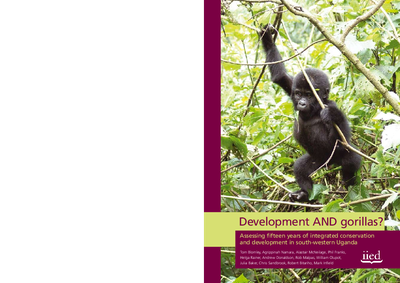Development AND Gorillas? Assessing Fifteen Years of Integrated Conservation and Development in South-Western Uganda

Author(s): T. Blomley, A. Namara, A. McNeilage, P. Franks, H. Rainer, A. Donaldson, R. Malpas
Publication Date: 2010
DOWNLOAD FILEKey points in document
- The report summarizes findings of a study carried out between 2001 and 2002 in and around Bwindi and Mgahinga, Uganda which aimed to test the effectiveness of integrated conservation and development (ICD) strategies that were implemented to reduce conflicts between local populations, biodiversity targets, and park staff.
- The study determined whether interventions aimed at improving local livelihoods could also promote conservation and identified and compared development interventions which had conservation effects.
- Six ICD strategies were researched: (1) regulated access to the park’s resources, (2) tourism, (3) revenue sharing, (4) a conservation trust fund, (5) sustainable agriculture development, and (6) resource substitution (i.e., the substitution of improved cook stoves for unsustainably harvested firewood or medicinal plant gardens for medicinal plants harvested from the forest).
- The report reviews the linkages between each strategy and their impact on community attitudes to conservation, cooperation with park authorities, and reducing illegal resource exploitation.
- The study found that community attitudes toward parks had improved since the creation of the park, and the ICD strategies seem to have supported this attitude shift.
- Though attitudes have changed, little evidence exists to support a change in behaviors; the community and park staff say that illegal activities have decreased, but there is no data to uphold the claim.
- “Coupling” interventions, which required the community to protect the natural resource in order to maintain an income stream, led to an increased willingness to manage and protect the resource over the long term.
- The “de-coupling” interventions, which provided the community with an alternative in order to reduce dependence on a natural resource, were less conclusive. Though projects were often successful in providing benefits to the community, the link between the “de-coupled” ICD, income streams, and a reduction in park dependence, was not strong.
- A success factor for ICD programs in the area may be the long-term funding support they received from external partners which has led to the development of strong institutional relationships with donors.
- The correct identification of conservation threats in the region led to tailored responses through the ICD programs, having a positive impact project success.
- The success of many ICD programs was traced back to projects ensuring that beneficiaries made the link between conservation and development (i.e., the association between the benefits generated through the agriculture program and the presence of the park making that program possible).
Information relevant to Learning Questions:
Are enabling conditions in place to support a sustainable enterprise?
- Participants’ Livelihood Needs are Met: stakeholder alignment,
- Access to credit/capital
- Business alliances
- Infrastructure
- Benefit sharing, targeted participants, biodiversity linkage, policies for and enforcement of resource use
Does the enterprise lead to benefits to stakeholders?
- Increased income for participants
Do the benefits lead to positive changes in attitudes and behavior?
- Attitudes regarding sustainable use of resources
- Behaviors regarding sustainable use of resources
Does a change in stakeholders’ behaviors lead to a reduction to threats to biodiversity (or restoration)?
- Agriculture and aquaculture
- Biological resource use
Does a reduction in threats (or restoration) lead to conservation?
- Forest ecosystems
Enterprise types:
- Agriculture
- Non-timber forest products: medicinal plants
- Ecotourism

